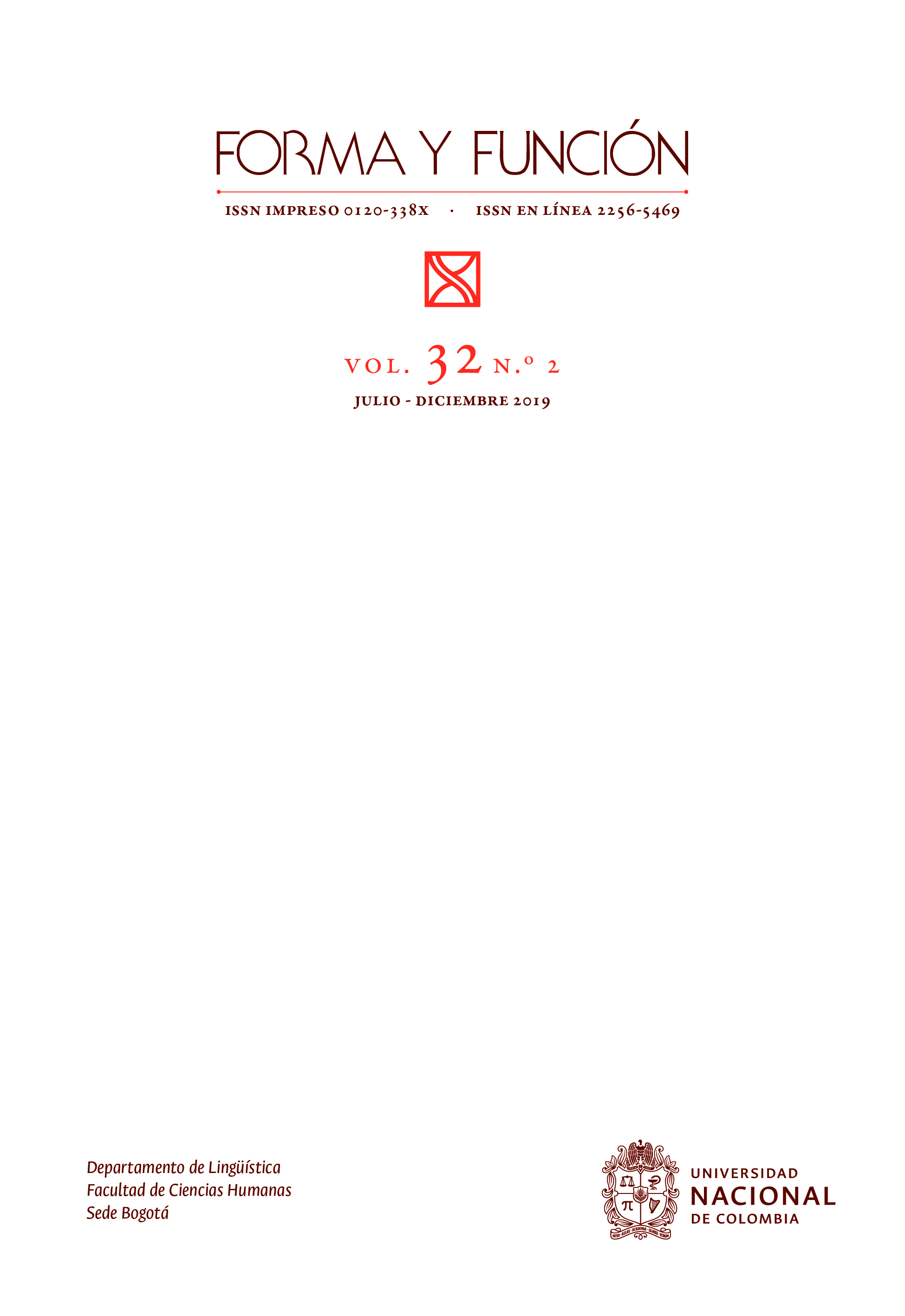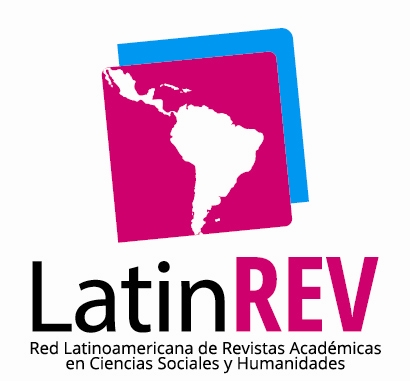La voz pasiva en yagán
The Passive Voice in Yahgan
A voz passiva em Yagán
DOI:
https://doi.org/10.15446/fyf.v32n2.80823Palabras clave:
lenguas indígenas, yagán, morfología, diátesis verbales, voz pasiva (es)indigenous languages, Yahgan, morphology, verbal diatheses, passive voice (en)
línguas indígenas, Yagán, morfologia, diáteses verbais, voz passiva (pt)
Descargas
Referencias
Adam, L. (1885). Grammaire de la langue jâgane. Paris: Maisonneuve et Leclerc.
Aguilera Faúndez, O. (2000). En torno a la estructura fonológica del yagán. Fonología de la palabra. Onomázein, 5, 233-241.
Alexiadou, A., & Schäfer F. (eds.). (2013). Non-Canonical Passives. Amsterdam/Philadelphia: John Benjamins. https://doi.org/10.1017/s0022226713000340
Alexiadou, A., Anagnostopoulou, E., & Schäfer, F. (2009). pp licensing in nominalizations. Proceedings of nels, 38, 39-52.
Araujo, S, Correia, A., & Real, C. (2013). Translating Pronominal Causative Constructions: se faire vs. hacerse/fazer-se + Inf. Procedia, 95, 344-353. https://doi.org/10.1016/j.sbspro.2013.10.656
Biber, D., Johansson, S., Leech, G., Conrad, S., & Finegan, E. (1999). Longman Grammar of Spoken and Written English. Harlow: Longman. https://doi.org/10.1017/s0022226702211627
Bostoen, K., & Nzang-Bié, Y. (2010). On how middle plus associative/reciprocal became passive in the Bantu A70 languages. Linguistics, 48(6), 1255-1307. https://doi.org/10.1515/ling.2010.041
Bridges, T. (1866). Yahgan Grammar in A. J. Ellis’ Phonetic System. Begun May 22nd 1866. Ms. Washington, dc: Library of Congress, Rare Book Room, pm 7266 B75.
Bridges, T. (1881). The Gospel of S. Luke translated into the Yahgan language. London: British and Foreign Bible Society.
Bridges, T. (1883). The Acts of the Apostles translated into the Yahgan language. London: British and Foreign Bible Society.
Bridges, T. (1886). The Gospel of S. John translated into the Yahgan language. London: British and Foreign Bible Society.
Bridges, T. (1894). A few notes on the structure of Yahgan. Journal of the Anthropological Institute of Great Britain and Ireland, 23, 53-80. https://doi.org/10.2307/2842315
Bridges, T. (1987 [1933]). Yamana-English. A dictionary of the speech of Tierra del Fuego. Ushuaia: Zagier y Urruty.
Bruening, B. (2013). By Phrases in Passives and Nominals. Syntax, 16(1), 1-41. https://doi.org/10.1111/j.1467-9612.2012.00171.x
Dixon, R. M. W., & Aikhenvald A. (2000) (eds.). Changing Valency: Case Studies in Transitivity. Cambridge: Cambridge University Press.
Dryer, M. (1986). Primary Objects, Secondary Objects, and Antidative. Language, 62, 808-845. https://doi.org/10.2307/415173
Ellis, A. J. (1845). The alphabet of nature; or, contributions towards a more accurate análisis and symbolization of spoken sounds. London: Bagster.
Ellis, A. J. (1846). Absolute completion of the phonotypic alphabet. The Phonotypic Journal, 5(4), 169-174.
Garbe, R. (1883). Eine vollständige Grammatik des Yâgan und ein Vokabular von ca. 30.000 Wörtern. Götting. Gelehrte Anzeigen, 1, 336-376.
Givon, T., & Yang L. (1994). The rise of the English get-passive. En B. Fox, & P. Hopper (eds.), Voice, Form and Function (pp. 119-150). Amsterdam/Philadelphia: John Benjamins.
Golbert, P. (1977). Yagan I. Las partes de la oración. Vicus, 1, 5-60.
Golbert, P. (1978). Yagan ii. Morfología nominal. Vicus, 2, 87-101.
Golbert, P. (1985a). Yagán iii: Morfología verbal. Ms.
Golbert, P. (1985b). Hacia una morfología verbal del yagán. International Journal of American Linguistics, 51(4), 421-424. https://doi.org/10.1086/465917
Gomes, D. M. (2006). Estudo morfológico e sintático língua Mundurukú (Tupí). Tese de doutorado em Linguística. Universidade de Brasília, Brasil.
Grimshaw, J. (1990). Argument Structure. Cambridge: mit Press
Guerra Eismann, A. M. (1989). Fonología del yagan. Tesis de Magister en Lingüística. uplaced, Chile.
Guerra Eismann, A. M. (1990). Esbozo fonológico del yagán. Actas del Octavo Seminario Nacional de Investigación y Enseñanza de la Lingüística (vol. v, pp. 88-93). Santiago: Universidad de Chile y Sociedad Chilena de Lingüística. https://doi.org/10.1017/s0272263100008986
Guerra Eismann, A. M. (1994). Acento y sílaba en un corpus yagán. Nueva Revista del Pacífico, 38-39, 271-276.
Guerra Eismann, A. M. (1995). Los sintemas del yagan. Actas de las II Jornadas de Lingüística Aborigen (pp. 271-276). Buenos Aires: Universidad de Buenos Aires.Haiman, J. (1983). Iconic and Economic Motivation. Language, 59, 781-819. https://doi.org/10.2307/413373
Hestermann, F. (1929). Das Pronomen im Yámana, Feuerland. International Journal of American Linguistics, 5(2/4), 150-179. https://doi.org/10.1086/463778
Kemmer, S. (1993). The Middle Voice. Amsterdam/Philadelphia. John Benjamins.
Kokutani, S. (2005). Sur l’analyse unie de la construction ‘se faire + infinitif’ en français. En H. B.-Z. Shyldkrot, & N. Querler (eds.), Les périphrases verbales (pp. 209-227). Amsterdam/Philadelphia: John Benjamins. https://doi.org/10.1075/lis.25.16kok
Koppers, W. (1927). Die fünf Dialekte in der Sprache der Yamana auf Feuerland. Anthropos, 22, 466-476.
Kroeger, P. R. (2004). Analyzing syntax: a lexical-functional approach. Cambridge University Press.
Kupferman, L. (1995). La construction passive en se faire. Journal of French Language Studies, 5, 57-83. https://doi.org/10.1017/s0959269500002507
Labelle, M. (2013) Anticausativizing a causative verb: The passive se faire construction in French. En A. Alexiadou, & F. Schäfer (eds.), Non-Canonical Passives (pp. 235-260). Amsterdam/Philadelphia: John Benjamins. https://doi.org/10.1075/la.205.11lab
Lakoff, R. (1971). Passive resistance. Papers from the Regional Meeting of the Chicago Linguistic Society, 7,149-162.
Le Bellec, C. (2014). La construction passive en ‘se faire’: Une forme concurrente et complémentaire du passif canonique. Journal of French Language Studies, 24(2), 203-222. https://doi.org/10.1017/s0959269513000033
Lyons, J. (1968). Introduction to Theoretical Linguistics. London: Cambridge University. Press.
Malchukov, A., Haspelmath, M., & Comrie, B. (eds.) (2010). Studies in Ditransitive Constructions. Berlin: Mouton de Gruyter.
Maldonado, R. (2010). Grammatical voice in cognitive grammar. En D. Geeraerts, & H. Cuyckens (eds.) The Oxford Handbook of Cognitive Linguistics (pp. 829-868). Oxford: Oxford University Press. https://doi.org/10.1093/oxfordhb/9780199738632.001.0001
Maslova, E. (2008). Reflexive Encoding of Reciprocity: Cross-Linguistic and Language-Internal Variation. En E. Konig, & V. Gast (eds.), Reciprocals and Reflexives. Theoretical and Typological Explorations (pp. 225-258). Berlin: Mouton de Gruyter. https://doi.org/10.1515/9783110199147.225
Platzmann, J. (1882). Glossar der feuerländischen Sprache. Leipzig: B. G. Teubner
Poblete Mendoza, M. T., & Salas, A. (1997). Fonemas yámana (yagán). Estructura fonológica de la palabra. Revista de Lingüística Teórica y Aplicada, 35, 125-133.
Regúnaga, M. A. (2014). Causativos en yagán. En M. Vedda, & J. P. Moris (comps.), Actas del VI Congreso Internacional de Letras. Buenos Aires: Editorial de la Facultad de Filosofía y Letras de la Universidad de Buenos Aires. https://doi.org/10.2307/2267473
Regúnaga, M. A. (2015). Reflexivos y recíprocos en yagan. En Z. Estrada Fernández, A. Fernández Garay, & A. Álvarez González (coords.), Estudios de lenguas amerindias 3: Escenarios de diversidad lingüística (pp. 169-193). Hermosillo: Editorial Universidad de Sonora.
Roeper, T. (1987). Implicit arguments and the head-complement relation. Linguistic Inquiry, 18, 267-310.
Salas, A., & Poblete Mendoza, M. T. (1997). Pares mínimos y estatus fonémico. ¿Causa o consecuencia? Revista de Lingüística Teórica y Aplicada, 35, 125-133.
Salas, A., & Valencia, A. (1990). El fonetismo del yámana o yagán. Una nota en lingüística de salvataje. Revista de Lingüística Teórica y Aplicada, 28, 147-169.
Schmidt, P. W. (1907). Die Sprachlaute und ihre Darstellung in einem allgemeinen linguistischen Alphabet/Les sons du langage et leur représentation dans un alphabet linguistique général. Anthropos, 2, 282-329, 508-587, 822-897, 1058-1105.
Shibatani, M. (1985). Passives and Related Constructions: A Prototype Analysis. Language, 61(4), 821-848. https://doi.org/10.2307/414491
Viegas Barros, J. P. (1994). Explorando la hipótesis del parentesco alacalufe-yagán. Lengua y Literatura Mapuche, 6, 281-285.
Wanner, A. (2013). The get-passive at the intersection of get and the passive. En A. Alexiadou, & F. Schäfer (eds.), Non-Canonical Passives (pp. 43-62). Amsterdam/Philadelphia: John Benjamins. https://doi.org/10.1075/la.205.03wan
Cómo citar
APA
ACM
ACS
ABNT
Chicago
Harvard
IEEE
MLA
Turabian
Vancouver
Descargar cita
CrossRef Cited-by
1. Máximo Farro, Marisa Malvestitti. (2023). Documentos inéditos en lenguas fuegopatagónicas (1880-1950). , p.13. https://doi.org/10.4000/books.eunrn.22232.
2. Jo Sindre P. Eidshaug, Hein B. Bjerck, Terje Lohndal, Ole Risbøl. (2024). Words as Archaeological Objects: A Study of Marine Lifeways, Seascapes, and Coastal Environmental Knowledge in the Yagan-English Dictionary. International Journal of Historical Archaeology, 28(3), p.722. https://doi.org/10.1007/s10761-024-00729-7.
Dimensions
PlumX
Visitas a la página del resumen del artículo
Descargas
Licencia
Derechos de autor 2019 Forma y Función

Esta obra está bajo una licencia internacional Creative Commons Atribución-NoComercial-CompartirIgual 4.0.
Forma y Función está suscrita al convenio Open Journal System, lo que significa que tiene el carácter de acceso abierto. Se provee acceso libre e inmediato a su contenido, bajo el principio de que hacer disponible gratuitamente los resultados de investigación contribuye a la divulgación global del conocimiento, así como al intercambio académico que propicia vínculos entre las comunidades científicas. Los usuarios pueden buscar, leer, copiar, descargar y compartir la totalidad de los textos publicados. Se autoriza su uso, siempre y cuando se conceda el crédito a los autores de los textos y a Forma y Función como fuente original de la publicación. No se permite el uso comercial de copia o distribución de contenidos, así como tampoco la adaptación, derivación o transformación alguna de estos sin la autorización previa de los autores y del editor de Forma y Función.
Los contenidos de la revista son publicados en acceso abierto bajo la Licencia Creative Commons Atribución-NoComercial-CompartirIgual 4.0 Internacional. Para mayor información sobre los términos de la licencia, se puede consultar: http://creativecommons.org/licenses/by-nc-sa/4.0/legalcode.
En consonancia con la política de acceso abierto, Forma y Función no aplica cargos por el procesamiento de los textos enviados, ni por su publicación.































